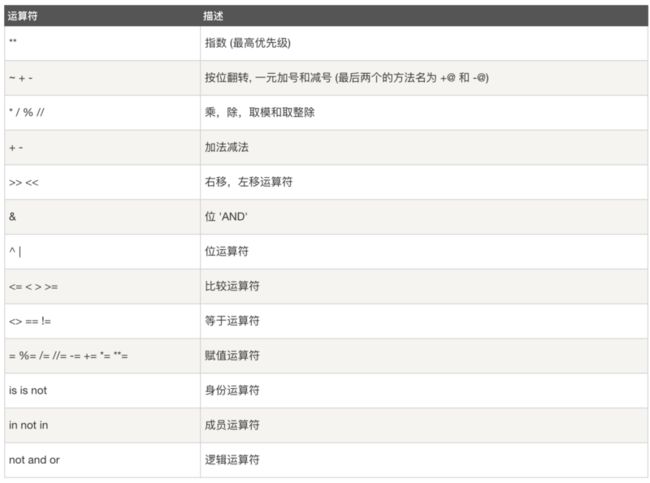表达式
表达式(Expression)是运算符(operator)和操作数(operand)所构成的序列
>>> 1 + 1
2
>>> a = [1,2,3]
>>> 1 + 1 + 1 + 1
4
>>> 1 + 2 * 3
7
>>> 1 * 2 + 3
5
>>> a = 1 + 2 * 3
>>> a = 1
>>> b = 2
>>> c = a and b or c
>>> c = int('1') + 2
运算符优先级
同级的运算符的优先级还是有区别的 比如逻辑运算符里的and的优先级大于or
>>> a = 1 >>> b = 2 >>> c = 3 >>> a + b * c 7 >>> 1 or 2 1 >>> 1 and 3 3 >>> a or b and c 1 >>> a or (b and c) 1 >>> a or 3 1 >>> (a or b) and c 3 >>> (a or b) and (c + 1) //两个括号同级,左结合 4 >>> a = 1 >>> b = 2 >>> c = a + b //出现赋值符号时,右结合 >>> print(c) 3 >>> c = a or b >>> print(c)
推荐的IDE:PyCharm、vsCode,大型工程适合用PyCharm,学习适合用vsCode,vsCode中推荐的插件:python、Terminal、Vim、vscode-icons
注释
单行注释用#
多行注释用 ''' 或者 """
流程控制语句
主要有条件控制(if else)、循环控制(for while)、分支
条件控制(if else)
# encoding: utf-8 mood = False if mood : print('go to left') # print('back away') # print('back away') else : print('go to right') a = 1 b = 2 c = 2 # if后面不仅可以是布尔值,还可以是表达式 if a or b + 1 == c : print('go to left') # print('back away') # print('back away') else : print('go to right')
# encoding: utf-8 """ 一段小程序 """ # constant 常量 建议全大写 ACCOUNT = 'hughie' PASSWORD = '123456' # python变量建议都用小写,用下划线分隔单词,不用驼峰命名 print('please input account') user_account = input() print('please input password') user_password = input() if ACCOUNT == user_account and PASSWORD == user_password: print('success') else: print('fail')
# encoding: utf-8 # snippet 片段 if condition: pass else: pass a = True if a: # pass 空语句/占位语句 pass else: print('') if True: pass if False: pass # 嵌套分支 if condition: if condition: pass else: pass else: if condition: pass else: pass # 代码块 if condition: code1 code11 code22 code333 code444 code5555 code6666 code2 code3 else: code1 code2 code3
改写为elif
# encoding: utf-8 """ a = x a = 1 print('apple') a = 2 print('orange') a = 3 print('banana') print('shopping') """ a = input() print('a is' + a) if a == 1: print('apple') else: if a == 2: print('orange') else: if a == 3: print('banana') else: print('shopping') # 改写为elif a = input() print(type(a)) print('a is ' + a) a = int(a) if a == 1: print('apple') elif a == 2: print('orange') elif a == 3: print('banana') else: print('shopping')
循环(while for)
# encoding: utf-8 # 循环 # 循环语句 # while for # CONDITION = True # while CONDITION: # print('I am while') counter = 1 # 递归常用while while counter <= 10: counter += 1 print(counter) else: print('EOF')
# encoding: utf-8 # 主要是用来遍历/循环 序列或者集合、字典 # a = ['apple', 'orange', 'banana', 'grape'] # for x in a: # print(x) # a = [['apple', 'orange', 'banana', 'grape'], (1, 2, 3)] # for x in a: # for y in x: # # print(y, end='') # print(y) # else: # print('fruit is gone') # a = [1, 2, 3] # for x in a: # if x == 2: # # break 遇到x==2的时候终止,打印出1 # # break # # continue 遇到x==2的时候跳过,打印出1,3 # continue # print(x) # else: # print('EOF') a = [['apple', 'orange', 'banana', 'grape'], (1, 2, 3)] for x in a: # if 'banana' in x: # break for y in x: if y == 'orange': # 内部循环跳出后,外部循环还在执行 break print(y) else: print('fruit is gone')
# encoding: utf-8 # for (i=0; i<10; i++){} # 以上的for循环用python实现 # for x in range(0, 10): # # range(0,10) 表示从0开始的10个数字,并不包含10 # print(x) # for x in range(0, 10, 2): # # range(0,10,2) 2表示步长 # print(x, end=' | ') # # 打印结果:0 | 2 | 4 | 6 | 8 | for x in range(10, 0, -2): print(x, end=' | ') # 打印结果:10 | 8 | 6 | 4 | 2 |
# encoding: utf-8 a = [1, 2, 3, 4, 5, 6, 7, 8] # for i in range(0, len(a), 2): # print(a[i], end=' | ') # 1 | 3 | 5 | 7 | b = a[0:len(a):2] print(b) # [1, 3, 5, 7]
